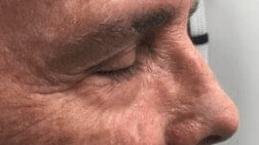What is an actinic keratosis or pre-cancer lesion?

Actinic Keratosis or AK is a rough scaly spot found on sun-damaged skin.
The spots (actinic keratoses) appear on skin that has had the greatest exposure to UV radiation from the sun like the face, balding scalp, ears, lips, chest, forearms, and backs of hands. The lesions are sometimes easier to feel than to see and can be red, flesh-colored, tan, brown, yellow, or white in color. It is often mistaken at first as just a small spot or spots of dry skin that do not go away with the use of a moisturizer.
These lesions are considered precancerous and if you have one AK you are likely to develop more over your lifetime.
The Skin Cancer Foundation estimates that 58 million Americans have one or more AKs. It is also estimated that 5-10% of AKs can develop into a type of skin cancer known as squamous cell carcinoma (SCC) which is the 2nd most common type of skin cancer and can in some instances become invasive. Having these lesions increases your lifetime risk of developing skin cancer since AKs are proof not only of a person’s degree of sun damage but also the skin’s inability to repair the damage done to the skin’s DNA by the UV light (mostly the UVB range of light – the type that causes sunburns [??] ).
AKs are usually pretty easy to diagnose by how they look clincally, but sometimes they may be biopsied to determine whether or not it is an AK or an SCC. If detected early AKs can be treated before they have the chance to develop into skin cancer – which is great news!
There are a number of treatments to destroy these – they range from in-office procedures to at-home treatments with prescription medications – all having a place depending on the number of lesions, sites involved, and what is felt to be best suited for that individual patient. In-office treatments consist of things like cryosurgery (freezing them) or the use of chemicals and special lights or lasers or even surgical options like cutting, scraping, and burning the affected skin.
At-home options usually consist of the use of prescription medicated creams that are applied by the patient at home following specific dosing instructions. Often in-office and at-home treatments are combined in order to give the patient the best and most thorough treatment and reduce the chances of the patient developing skin cancer.
This diagnosis can be ultimately be avoided by long-term use of sunscreen, practicing safe sun habits, and making it a priority to having your skin checked yearly.
